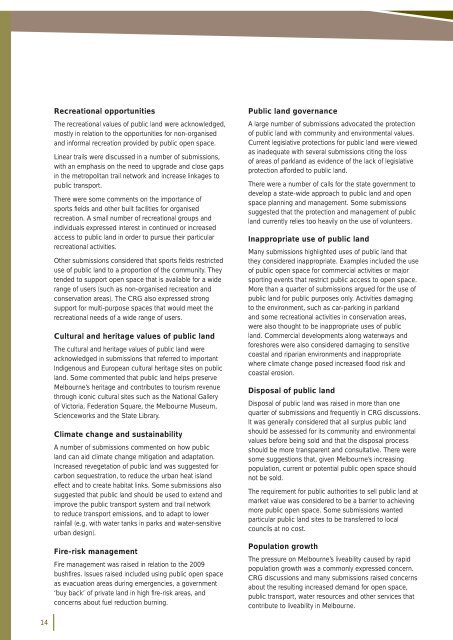Metropolitan Melbourne Investigation Discussion Paper - Victorian ...
Metropolitan Melbourne Investigation Discussion Paper - Victorian ...
Metropolitan Melbourne Investigation Discussion Paper - Victorian ...
Create successful ePaper yourself
Turn your PDF publications into a flip-book with our unique Google optimized e-Paper software.
Recreational opportunities<br />
The recreational values of public land were acknowledged,<br />
mostly in relation to the opportunities for non-organised<br />
and informal recreation provided by public open space.<br />
Linear trails were discussed in a number of submissions,<br />
with an emphasis on the need to upgrade and close gaps<br />
in the metropolitan trail network and increase linkages to<br />
public transport.<br />
There were some comments on the importance of<br />
sports fi elds and other built facilities for organised<br />
recreation. A small number of recreational groups and<br />
individuals expressed interest in continued or increased<br />
access to public land in order to pursue their particular<br />
recreational activities.<br />
Other submissions considered that sports fi elds restricted<br />
use of public land to a proportion of the community. They<br />
tended to support open space that is available for a wide<br />
range of users (such as non-organised recreation and<br />
conservation areas). The CRG also expressed strong<br />
support for multi-purpose spaces that would meet the<br />
recreational needs of a wide range of users.<br />
Cultural and heritage values of public land<br />
The cultural and heritage values of public land were<br />
acknowledged in submissions that referred to important<br />
Indigenous and European cultural heritage sites on public<br />
land. Some commented that public land helps preserve<br />
<strong>Melbourne</strong>’s heritage and contributes to tourism revenue<br />
through iconic cultural sites such as the National Gallery<br />
of Victoria, Federation Square, the <strong>Melbourne</strong> Museum,<br />
Scienceworks and the State Library.<br />
Climate change and sustainability<br />
A number of submissions commented on how public<br />
land can aid climate change mitigation and adaptation.<br />
Increased revegetation of public land was suggested for<br />
carbon sequestration, to reduce the urban heat island<br />
effect and to create habitat links. Some submissions also<br />
suggested that public land should be used to extend and<br />
improve the public transport system and trail network<br />
to reduce transport emissions, and to adapt to lower<br />
rainfall (e.g. with water tanks in parks and water-sensitive<br />
urban design).<br />
Fire-risk management<br />
Fire management was raised in relation to the 2009<br />
bushfi res. Issues raised included using public open space<br />
as evacuation areas during emergencies, a government<br />
‘buy back’ of private land in high fi re-risk areas, and<br />
concerns about fuel reduction burning.<br />
Public land governance<br />
A large number of submissions advocated the protection<br />
of public land with community and environmental values.<br />
Current legislative protections for public land were viewed<br />
as inadequate with several submissions citing the loss<br />
of areas of parkland as evidence of the lack of legislative<br />
protection afforded to public land.<br />
There were a number of calls for the state government to<br />
develop a state-wide approach to public land and open<br />
space planning and management. Some submissions<br />
suggested that the protection and management of public<br />
land currently relies too heavily on the use of volunteers.<br />
Inappropriate use of public land<br />
Many submissions highlighted uses of public land that<br />
they considered inappropriate. Examples included the use<br />
of public open space for commercial activities or major<br />
sporting events that restrict public access to open space.<br />
More than a quarter of submissions argued for the use of<br />
public land for public purposes only. Activities damaging<br />
to the environment, such as car-parking in parkland<br />
and some recreational activities in conservation areas,<br />
were also thought to be inappropriate uses of public<br />
land. Commercial developments along waterways and<br />
foreshores were also considered damaging to sensitive<br />
coastal and riparian environments and inappropriate<br />
where climate change posed increased fl ood risk and<br />
coastal erosion.<br />
Disposal of public land<br />
Disposal of public land was raised in more than one<br />
quarter of submissions and frequently in CRG discussions.<br />
It was generally considered that all surplus public land<br />
should be assessed for its community and environmental<br />
values before being sold and that the disposal process<br />
should be more transparent and consultative. There were<br />
some suggestions that, given <strong>Melbourne</strong>’s increasing<br />
population, current or potential public open space should<br />
not be sold.<br />
The requirement for public authorities to sell public land at<br />
market value was considered to be a barrier to achieving<br />
more public open space. Some submissions wanted<br />
particular public land sites to be transferred to local<br />
councils at no cost.<br />
Population growth<br />
The pressure on <strong>Melbourne</strong>’s liveability caused by rapid<br />
population growth was a commonly expressed concern.<br />
CRG discussions and many submissions raised concerns<br />
about the resulting increased demand for open space,<br />
public transport, water resources and other services that<br />
contribute to liveability in <strong>Melbourne</strong>.<br />
14
















